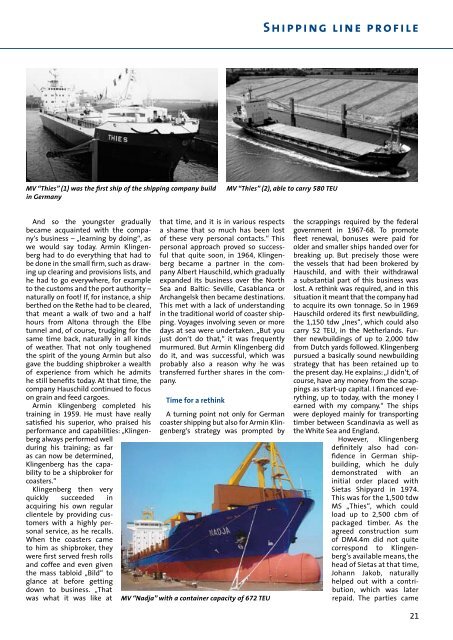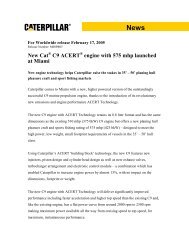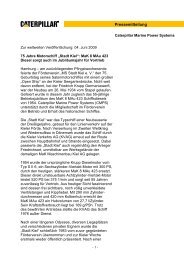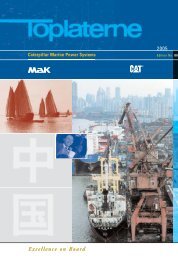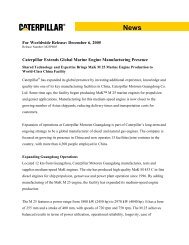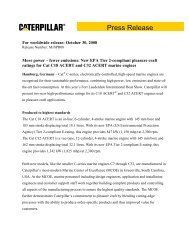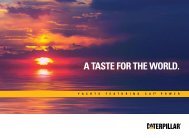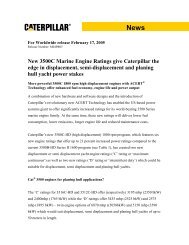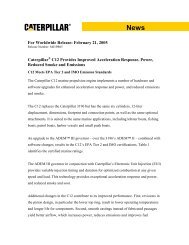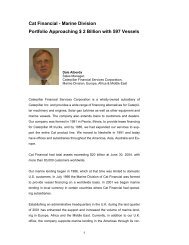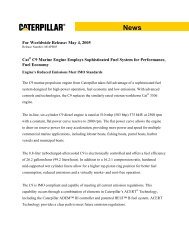Caterpillar Marine - Marine Engines Caterpillar
Caterpillar Marine - Marine Engines Caterpillar
Caterpillar Marine - Marine Engines Caterpillar
Create successful ePaper yourself
Turn your PDF publications into a flip-book with our unique Google optimized e-Paper software.
MV “Thies” (1) was the first ship of the shipping company build<br />
in Germany<br />
And so the youngster gradually<br />
became acquainted with the company‘s<br />
business – „learning by doing“, as<br />
we would say today. Armin Klingenberg<br />
had to do everything that had to<br />
be done in the small firm, such as drawing<br />
up clearing and provisions lists, and<br />
he had to go everywhere, for example<br />
to the customs and the port authority –<br />
naturally on foot! If, for instance, a ship<br />
berthed on the Rethe had to be cleared,<br />
that meant a walk of two and a half<br />
hours from Altona through the Elbe<br />
tunnel and, of course, trudging for the<br />
same time back, naturally in all kinds<br />
of weather. That not only toughened<br />
the spirit of the young Armin but also<br />
gave the budding shipbroker a wealth<br />
of experience from which he admits<br />
he still benefits today. At that time, the<br />
company Hauschild continued to focus<br />
on grain and feed cargoes.<br />
Armin Klingenberg completed his<br />
training in 1959. He must have really<br />
satisfied his superior, who praised his<br />
performance and capabilities: „Klingenberg<br />
always performed well<br />
during his training; as far<br />
as can now be determined,<br />
Klingenberg has the capability<br />
to be a shipbroker for<br />
coasters.“<br />
Klingenberg then very<br />
quickly succeeded in<br />
acquiring his own regular<br />
clientele by providing customers<br />
with a highly personal<br />
service, as he recalls.<br />
When the coasters came<br />
to him as shipbroker, they<br />
were first served fresh rolls<br />
and coffee and even given<br />
the mass tabloid „Bild“ to<br />
glance at before getting<br />
down to business. „That<br />
was what it was like at<br />
that time, and it is in various respects<br />
a shame that so much has been lost<br />
of these very personal contacts.“ This<br />
personal approach proved so successful<br />
that quite soon, in 1964, Klingenberg<br />
became a partner in the company<br />
Albert Hauschild, which gradually<br />
expanded its business over the North<br />
Sea and Baltic: Seville, Casablanca or<br />
Archangelsk then became destinations.<br />
This met with a lack of understanding<br />
in the traditional world of coaster shipping.<br />
Voyages involving seven or more<br />
days at sea were undertaken. „But you<br />
just don‘t do that,“ it was frequently<br />
murmured. But Armin Klingenberg did<br />
do it, and was successful, which was<br />
probably also a reason why he was<br />
transferred further shares in the company.<br />
Time for a rethink<br />
A turning point not only for German<br />
coaster shipping but also for Armin Klingenberg‘s<br />
strategy was prompted by<br />
MV “Nadja” with a container capacity of 672 TEU<br />
Shipping line profile<br />
MV “Thies” (2), able to carry 580 TEU<br />
the scrappings required by the federal<br />
government in 1967-68. To promote<br />
fleet renewal, bonuses were paid for<br />
older and smaller ships handed over for<br />
breaking up. But precisely those were<br />
the vessels that had been brokered by<br />
Hauschild, and with their withdrawal<br />
a substantial part of this business was<br />
lost. A rethink was required, and in this<br />
situation it meant that the company had<br />
to acquire its own tonnage. So in 1969<br />
Hauschild ordered its first newbuilding,<br />
the 1,150 tdw „Ines“, which could also<br />
carry 52 TEU, in the Netherlands. Further<br />
newbuildings of up to 2,000 tdw<br />
from Dutch yards followed. Klingenberg<br />
pursued a basically sound newbuilding<br />
strategy that has been retained up to<br />
the present day. He explains: „I didn‘t, of<br />
course, have any money from the scrappings<br />
as start-up capital. I financed everything,<br />
up to today, with the money I<br />
earned with my company.“ The ships<br />
were deployed mainly for transporting<br />
timber between Scandinavia as well as<br />
the White Sea and England.<br />
However, Klingenberg<br />
definitely also had confidence<br />
in German shipbuilding,<br />
which he duly<br />
demonstrated with an<br />
initial order placed with<br />
Sietas Shipyard in 1974.<br />
This was for the 1,500 tdw<br />
MS „Thies“, which could<br />
load up to 2,500 cbm of<br />
packaged timber. As the<br />
agreed construction sum<br />
of DM4.4m did not quite<br />
correspond to Klingenberg‘s<br />
available means, the<br />
head of Sietas at that time,<br />
Johann Jakob, naturally<br />
helped out with a contribution,<br />
which was later<br />
repaid. The parties came<br />
21


